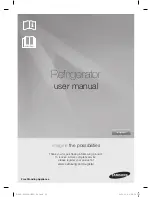
12
Troubleshooting
While using your appliance, you may come across some problems that in most
cases result from improper handling. Many of these can easily be eliminated by
following the suggestions listed here.
The appliance fails to operate after connecting to the power supply.
• Check that there is power in the electrical socket.
• Make sure the appliance is switched on (thermostat is in the operating
position).
The refrigeration system is operating continuously.
• The door was frequently opened or it was left open too long.
• The door is not properly closed (the door may sag; the gasket may be dirty
or damaged).
• The appliance may be overloaded with fresh foods.
• There may be inadequate ventilation of the compressor and condenser.
(Be sure there is sufficient air circulation. Wipe off the condenser.)
Ice is forming on the inner rear wall.
As long as the defrost water runs to the channel and through the opening to
the drain pan on the compressor, automatic defrosting of the refrigerator
compartment is assured. If the ice formation on the inner back wall increases
to 1/8” or more, the ice should be manually defrosted as follows:
Set the thermostat knob to
OFF
and leave the door open. Never use electric
devices for defrosting and do not scrape the ice or frost layer with sharp
objects. When defrosting is completed, turn the knob to the desired position
and close the refrigerator door.
Increased ice formation may be caused by one of the following:
-
The door does not seal well (clean the gasket if it is contaminated, or
replace it if it is damaged).
-
The door was frequently opened or it was left open for too long.
-
Food was warm when placed in the refrigerator.
-
The food or a container is touching the inner back wall.
Water is leaking from the refrigerator
.
In case the discharge water outlet is clogged or the defrost water drips over
the channel resulting in water leaking from the refrigerator, just clean the
clogged opening with a plastic straw. Manually defrost the increased ice layer.
See
I
ce is forming on the inner rear wall
above.
Summary of Contents for CP351W
Page 15: ...14 Notes ...


































